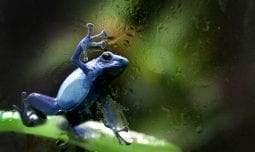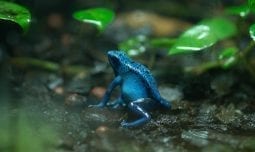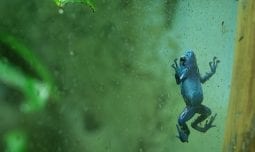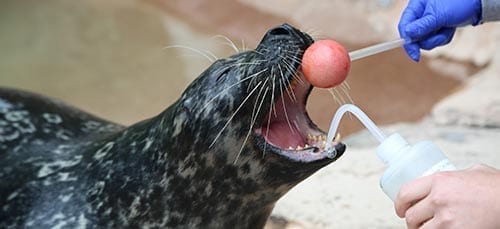Classification
Class Amphibia
Order Anura
Family Dendrobatidae
Genus Dendrobates
Species azureus
Habitat & Range
These frogs are found in warm humid rainforest areas surrounded by dry savannah and always near small streams among moss covered rocks.
Blue poison arrow frogs are found only in the Sipaliwini savannah in the South American country of Suriname.

Blue Poison Arrow Frog
Dendrobates azureus
Although many frogs are green or have muted colors and patterns that help them hide from potential predators, some frogs like the blue poison arrow frog use bright colors as a means of defense. The brilliant blue color of these frogs serves as a warning to potential predators not to eat it. Often the more vibrant and colorful a frog is, the more poisonous it may be.
Adaptations
Poison Skin
The most amazing adaptation these frogs have is their ability to produce toxins. The toxins in the skin of these frogs are found in high concentrations in the prey they eat, especially ants. After eating the ants, these toxic compounds are secreted by glands in the frog’s skin providing them with a powerful means of defense. The toxin is capable of paralyzing or even killing potential predators. The blue poison arrow frog contains an average of 200 micrograms of poison which would cause harm and could possibly prove fatal even to a human.
Deadly Colors
Although many frogs are green or have muted colors and patterns that help them hide from potential predators, some frogs like the blue poison arrow frog use bright colors as a means of defense. The brilliant blue color of these frogs serves as a warning to potential predators not to eat it. Often the more vibrant and colorful a frog is, the more poisonous it may be.
Physical Description
- The blue poison arrow frog is 1.2 to 1.8 inches (3-4.5 cm) long; females are larger than males.
- These frogs weigh about one-tenth of an ounce (3 grams).
- These frogs have azure blue on their legs, sky blue on the back and darker blue on the belly with an irregular pattern of dark blue and black spots covering their back and head.
Diet
What Does It Eat?
In the wild: Ants, beetles, flies, mites, spiders, termites, maggots, caterpillars.
At the zoo: Crickets and fruit flies.
What Eats It?
Adults are eaten by snakes and large spiders; tadpoles are preyed on by snakes and dragonfly larvae.
Social Organization
Blue poison arrow frogs are solitary except during breeding or territorial fights.
Life Cycle
Like all frogs, blue poison arrow frogs undergo a metamorphosis starting out as eggs that hatch into tadpoles and live in the water breathing oxygen through gills. The tadpoles slowly change into adult frogs growing legs, absorbing the tail, losing the gills and developing lungs enabling them to breathe oxygen in the air. Breeding usually occurs during the rainy season. Males establish a territory and announce their position with quiet calls in order to attract a female. Several females may fight over the male. The victorious female begins the courtship ritual by nudging the male on the side and stroking his back with her front legs. The mated pair then moves to a secluded spawning chamber near a water source to mate and lay eggs. The male looks after the eggs keeping them moist until they hatch in 14-18 days. Once the tadpoles hatch, the male carries them on his back and deposits them in small pools of water in a tiny tree hole or inside a bromeliad. The female may help care for the eggs and transport tadpoles. Once the tadpoles have been placed in water, the male’s care ends but the female will visit the tadpoles frequently to place unfertilized eggs in the water to provide food for the tadpoles. The tadpoles metamorphose into adult frogs in 10-12 weeks. Lifespan in the wild is four to six years and in captivity they live an average of 10 years.
Fun Facts
- The pattern of spots on each frog is unique and like human fingerprints, can be used to identify individual frogs.
- In captivity, the blue poison arrow frog loses its poisonous properties due to the lack of toxic substances in the food they eat.
- The blue poison arrow frog is one of 120 species that includes the most poisonous amphibians in the world.
- The American Zoo and Aquarium Association declared 2008 “The Year of the Frog” to emphasize the global crisis affecting amphibians. One third of all amphibian species worldwide are threatened with extinction.
Conservation Status
IUCN Status: Least Concern
The 2008 IUCN Red List classifies Dendrobates azureus as a synonym of Dendrobates tinctorius, which has a wide distribution and a presumed large population. It is generally thought that the blue poison arrow frog is a vulnerable species due to loss of rainforest habitat and the illegal pet trade. Captive breeding programs may help insure the survival of this unique species as well as other endangered frog species.

Download the App!
Get the FREE Denver Zoo app today, and be a pro the next time you visit the Zoo. You’ll get access to the Zoo map, daily activities and schedules, animal facts, and more. You can even load your membership card onto the app for additional convenience. It puts everything you need for an amazing Zoo experience right into the palm of your hand!





